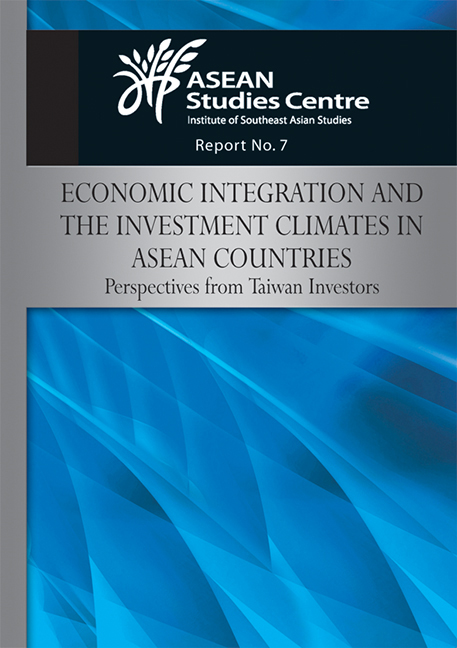 Economic Integration and the Investment Climates in ASEAN Countries
Economic Integration and the Investment Climates in ASEAN Countries from II - Background Papers
Published online by Cambridge University Press: 21 October 2015
This paper is an attempt to look at economic interactions between Association of Southeast Asian Nations (ASEAN) and Taiwan since the late 1980s, which reflect on the forces of regionalization and globalization. Its underlying intention is to develop some insights into issues, which argue that ASEAN and Taiwan have created a format for regional economic partnerships. These insights may facilitate a flexible approach towards an examination of the prospects and opportunities between them in the era of regionalization and globalization. As a hypothesis, if there are constraints (that is, without formal relations between Taiwan and ASEAN countries) or opportunities (that is, long-term economic interdependence between Taiwan and ASEAN) in trying to target a goal of comprehensive cooperation between ASEAN and Taiwan, it would require the use of political and economic approaches to examine these specific issues.
As its methodology, this paper uses mainly trade and investment data between Taiwan and six of ASEAN's member-countries (ASEAN-6) to indicate the complementary attributes of ASEAN countries and Taiwan. It is further shown that economic forces, driven by foreign direct investment and trade, have built a sense of a regional economic community between Taiwan and the ASEAN-6 since the late 1980s. From a practical perspective, the emergence of close economic relations among Taiwan and ASEAN-6 reflects the fact that these countries pursued their economic comparative advantages so as to maintain their global competitiveness. Based on the above, this paper is structured as follows. Section 1 explores the notion of regionalization and globalization, which helps us to understand the essence of common interests between ASEAN and Taiwan. It is argued that cooperation between ASEAN and Taiwan should be regarded as a means or process undertaken by individual countries to pursue national, regional and global interests.
To save this book to your Kindle, first ensure [email protected] is added to your Approved Personal Document E-mail List under your Personal Document Settings on the Manage Your Content and Devices page of your Amazon account. Then enter the ‘name’ part of your Kindle email address below. Find out more about saving to your Kindle.
Note you can select to save to either the @free.kindle.com or @kindle.com variations. ‘@free.kindle.com’ emails are free but can only be saved to your device when it is connected to wi-fi. ‘@kindle.com’ emails can be delivered even when you are not connected to wi-fi, but note that service fees apply.
Find out more about the Kindle Personal Document Service.
To save content items to your account, please confirm that you agree to abide by our usage policies. If this is the first time you use this feature, you will be asked to authorise Cambridge Core to connect with your account. Find out more about saving content to Dropbox.
To save content items to your account, please confirm that you agree to abide by our usage policies. If this is the first time you use this feature, you will be asked to authorise Cambridge Core to connect with your account. Find out more about saving content to Google Drive.